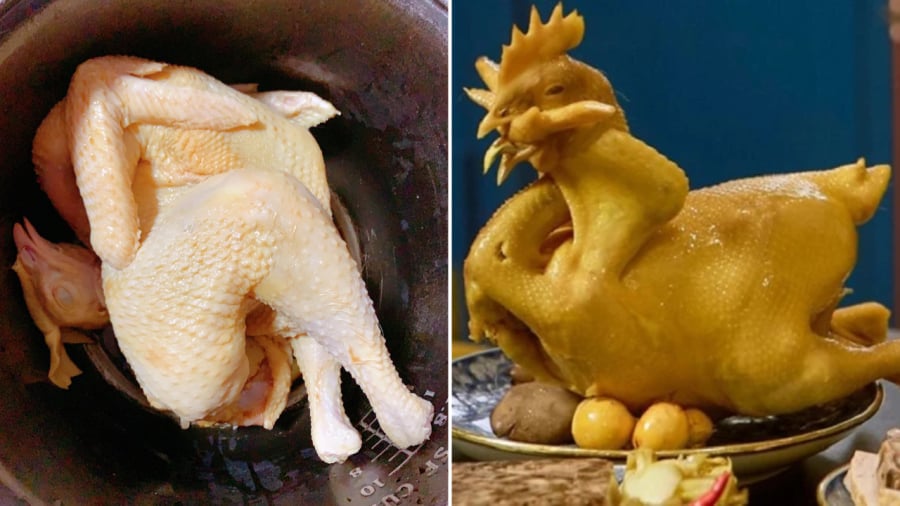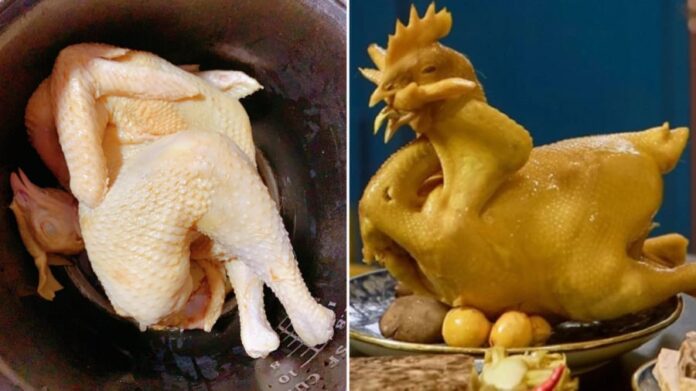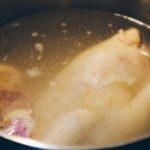Should You Boil a Chicken Breast-Side Up or Down to Prevent Cracked Skin and Red Bones?
Boiled chicken is a traditional dish that graces the tables of Vietnamese families on various occasions, especially during the Lunar New Year. While boiling chicken is not a difficult task, not everyone knows the trick to getting it just right – with evenly cooked meat, a golden skin, and no cracks or red bones.
The way you place the chicken in the pot is an important factor that affects the flavor and quality of the cooked chicken. When boiling a whole chicken, should you place it breast-side down or up?
The position of the chicken in the pot will influence the heat distribution and cooking speed. Usually, the thicker parts like the breast and thighs take the longest to cook.
If you place the chicken breast-side down, these thicker parts are submerged in the water and cook faster. The back of the chicken, which is thinner, remains above the water and receives less direct heat. However, due to its thinner nature, it still cooks thoroughly.

The position of the chicken in the pot affects heat distribution and cooking speed.
When the chicken is placed breast-side up, the thicker parts of the meat are at the top and receive less heat, causing them to cook more slowly. Meanwhile, the thinner back portion, which is in direct contact with the heat, cooks faster and is more prone to skin ruptures, losing its desired tautness and gloss. However, when placed in this position, the boiling water enters the cavity, causing the meat inside to cook faster.
According to professional chefs, whether you place the chicken breast-side up or down is just one factor to consider. It is best to combine both positions during the boiling process.
When you start boiling, place the chicken breast-side down so that the breast and thighs receive more heat. Boil for about 10 minutes from the time the water starts boiling.
Then, turn the chicken breast-side up so that the boiling water fills the cavity, allowing the breast and thigh meat to cook more evenly. Continue boiling for another 10-15 minutes.
Some Tips for Boiling Chicken:
When boiling chicken, consider adding spices like ginger, onion, and lemongrass to enhance the flavor.
Make sure the water level is high enough to submerge the entire chicken, ensuring even cooking and preventing the skin from drying out or shrinking. Once the water boils, reduce the heat to maintain a gentle simmer. Avoid boiling the water too vigorously, as this can cause the meat to be undercooked on the inside while overcooking the outside, and it may also lead to skin ruptures.
After boiling, don’t rush to remove the chicken from the pot. Instead, cover it and let it steam for an additional 5-10 minutes to ensure it’s thoroughly cooked and juicy.
Finally, immerse the cooked chicken in ice-cold water for about 5 minutes to tighten and crisp the skin.
The Ultimate Guide to Perfectly Cooked Chicken: Unlocking the Secret to Crisp Skin and Juicy Meat
With this simple boiled chicken recipe, you’ll be able to create a mouth-watering dish that will have your neighbors drooling with envy. Achieve the perfect balance of tender, juicy meat and crisp, golden skin with our expert tips and tricks. Say goodbye to rubbery chicken and hello to a delicious masterpiece!



































